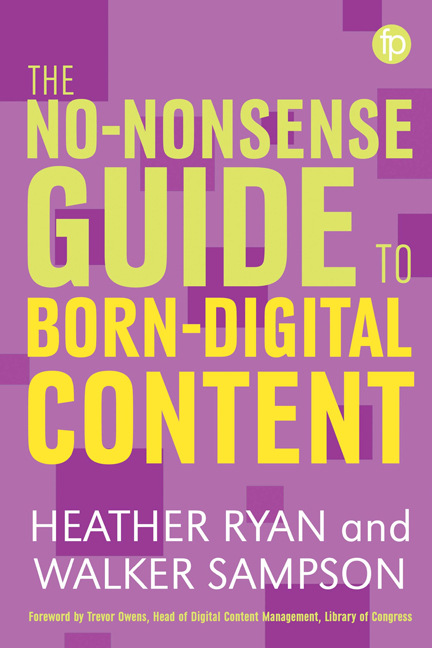Book contents
- Frontmatter
- Contents
- List of figures and tables
- Foreword
- Acknowledgements
- List of abbreviations
- Glossary
- Introduction
- 1 Digital information basics
- 2 Selection
- 3 Acquisition, accessioning and ingest
- 4 Description
- 5 Digital preservation storage and strategies
- 6 Access
- 7 Designing and implementing workflows
- 8 New and emerging areas in born-digital materials
- Conclusion
- References
- Appendix A Resources
- Appendix B Basic Unix command line prompts
- Index
1 - Digital information basics
Published online by Cambridge University Press: 08 June 2018
- Frontmatter
- Contents
- List of figures and tables
- Foreword
- Acknowledgements
- List of abbreviations
- Glossary
- Introduction
- 1 Digital information basics
- 2 Selection
- 3 Acquisition, accessioning and ingest
- 4 Description
- 5 Digital preservation storage and strategies
- 6 Access
- 7 Designing and implementing workflows
- 8 New and emerging areas in born-digital materials
- Conclusion
- References
- Appendix A Resources
- Appendix B Basic Unix command line prompts
- Index
Summary
Computers are the most complex objects we human beings have ever created, but in a fundamental sense they are remarkably simple.
(Danny Hillis, The Pattern on the Stone, 1998, vii)Learning how to preserve, conserve and describe paper-based materials usually entails learning about what the paper is made of and how it was made. It also involves knowing how the ink was made and how it was applied to the paper. Interpreting messages fixed on paper also requires an understanding of the language in which the messages were written, which also requires knowledge of the shapes and symbols used in the language represented. Understanding the basics of preserving and interpreting born-digital information is no different. It helps to understand how digital information is encoded and fixed onto physical media to make informed decisions about how best to preserve and provide access to it.
This chapter explains basic encoding methods used to convert various types of information into digital form, describes how digital information is fixed onto physical mediums and discusses basics of the command line and navigating code repositories. This may feel like an intimidating chapter to start with, but once you understand the concepts presented here, the rest of the principles and processes presented throughout the book will be simple to master.
What is digital information?
At a basic level, the word digital refers to information that is expressed in digits, or numbers; more specifically the numbers 1 and 0. The numbers 1 and 0 represent any kind of binary information presentation. This can be the presence (1) or absence (0) of something, different orientations of something like up (1) or down (0), statements of truth like TRUE (1) or FALSE (0), polar orientation like North (1) or South (0), dashes (1) or dots (0) like in Morse code; basically anything that can be represented by a maximum of two different states. Since digital information is encoded into only one of two digits, it is also referred to as ‘binary’ encoding, where ‘bi’ means ‘two’. Each individual digit (a 1 or a 0) is called a ‘bit’. A string of eight bits is called a ‘byte’.
- Type
- Chapter
- Information
- The No-nonsense Guide to Born-digital Content , pp. 9 - 30Publisher: FacetPrint publication year: 2018



